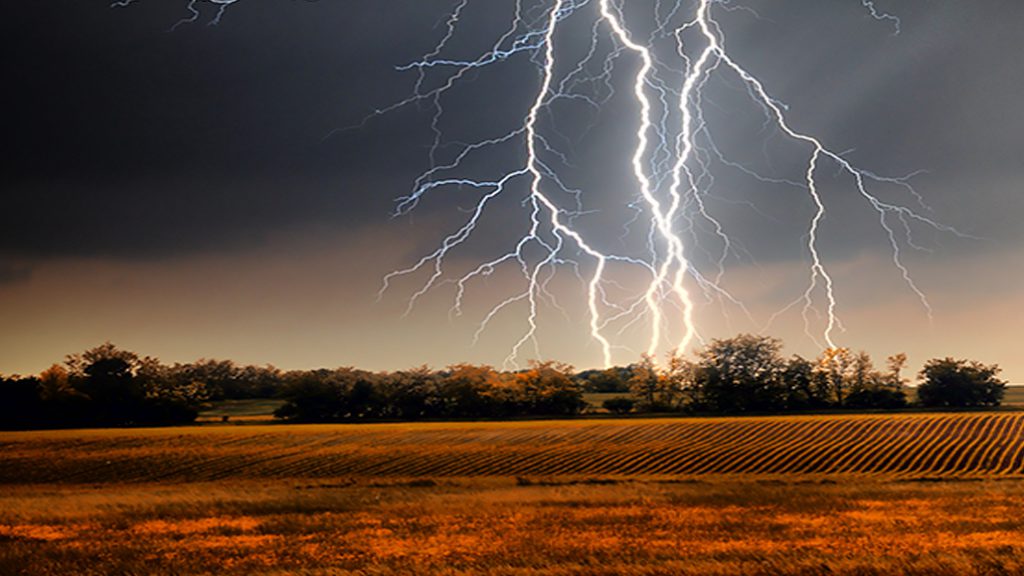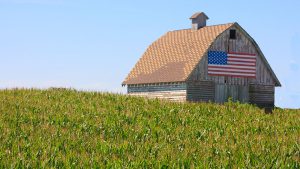Extreme weather
THUNDERSTORM SAFETY IN THE FIELD

FARMING IS ALMOST synonymous with the weather. Good or bad weather can make or break a growing season for a farmer — so it’s important to be very in-tune with current and forecasted weather to make decisions around field work. Luckily, technology has come a long way in helping farmers work with a longer or shorter growing season. Hybrids have been created to withstand drought as well as disease and insect pressures that can rear up as a result of a too-dry or too-wet season.
But farmers and farms still face many obstacles when it comes to the weather, affecting planting, spraying, harvest, and more, even posing safety concerns as it happens.
Inclement weather in the form of thunderstorms which produce lightning and the potential for tornadoes can occur frequently throughout the summer months, so it’s important that farmers are prepared for extreme weather events.
BUILDINGS

Farm structures are typically out in the open and silos are usually the tallest structure in the area, making them the likeliest target for a lightning strike.
“Most farmers are aware that tall buildings like silos or cell phone towers need a lightning rod,” says Dan Kottlowski, senior meteorologist, Accuweather. “Silos and cell phone towers attract lightning, but they can also arc and hit other structures — so every structure needs to be protected.”
Fires are a common result of lightning strikes, especially in barns. Having a plan in place to deal with fires in the event one occurs is critical in preventing losses and damage.
IN THE FIELD
Farmers keep a close eye on the weather, so they are typically in tune with any weather forecasts that could alter their plans. However, they can run into trouble when they’re out in the field working to beat the storm, risking getting caught in the field as a storm rolls in.
In the middle of the field, tractors are usually the tallest object. Fortunately, the safest place to be during a thunderstorm is in a vehicle, so staying inside the cab of the tractor is an ideal location given the circumstances. According to Kottlowski, in a combine, the header can attract lightning and it can travel through the machine, so drivers should lift the header off the ground. The same is true for plowing or discing the field — operators need to lift the equipment off the ground.
Lightning can strike as much as 16 kilometres away from an approaching thunderstorm, and in a tractor, you lose the ability to hear thunder from a distance. If storms are forecasted, farmers need to keep a close eye on the weather while conducting work. Lightning interferes with AM radio frequencies, so turning on the radio and listening to the frequency of strikes can give clues to the severity of the storm.
TORNADOES
Southwestern Ontario from London to the Niagara Region reports the greatest number of tornadoes each year. The Great Lakes provide enough warm, moist air in an unstable atmosphere to create a good environment for tornadoes to build. Ontario averages 15 tornadoes per year which typically cause minor structural damage to barns, wood fences, roof shingles, and chimneys, and downed tree limbs and power lines.
“Tornadoes can be difficult to see and detect — unless you’re looking for them, it’s hard to tell,” says Kottlowski. “Tornadoes can result from thunderstorms picking up wind and can be embedded within the storm. This can catch people off guard. However, tornado threats are well-communicated through radio, the internet, and cell phone alerts to raise awareness if there is a chance of tornadoes.”
In the event of a tornado warning, seek shelter immediately indoors if possible.
WATCH VS WARNING
Environment Canada will issue a watch or a warning for inclement weather. A watch means conditions are favourable for the development of tornadoes or severe thunderstorms and farmers should be on heightened alert for possible weather-related problems (eye on the sky). Watches are often issued a few hours before any threatening weather arrives at a particular spot.
When radar detects, or someone reports, a tornado or a damaging thunderstorm a warning is issued. AccuWeather.com has an app that triggers a tone alert for warnings for where your cell phone is located. Most cell phones can be set to give a very loud tone alert and even vibrate when a warning is issued so they can be heard or felt even when operating loud machinery.
BEING PREPARED
According to Accuweather, this summer there is a higher risk for severe thunderstorms and tornadoes over Ontario and southern Quebec, including Toronto, Ottawa, Hamilton, Montreal, and Quebec City.
“The strongest storms of the season will be capable of producing damaging winds, hail, and isolated tornadoes. However, any thunderstorm that moves through the region will bring the risk of flash flooding, especially in urban areas.”
Kottlowski adds, “farmers are commonsense people. But, they will try to get things done before a storm hits — which can make them run into trouble. The best idea is to have a plan if you do want to take a chance to know how to deal with any weather events that might arise.”
The best way to prevent damage, injury, or even death is to understand the risks and have a plan to implement when a storm hits. Emergency preparedness is critical for any farming operation for people and livestock. •










